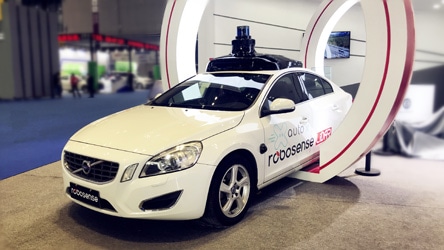RoboSense (Suteng Innovation Technology Co., Ltd) www.robosense.ai announced today at the Shanghai Auto Show that it has teamed up with partners Horizon Robotics, Cainiao Network, Sensible 4, and AutoX to launch the Smart Sensor System (SSS) designed for four key smart transportation vehicle applications: autonomous passenger cars, low-speed autonomous vehicles, high-speed RoboTaxis, and V2R (Vehicle to Road infrastructure). The RoboSense Smart Sensor System combines new LiDAR hardware, AI point cloud algorithms, and an IC design for a one stop Smart Sensor System strategy that collects and interprets environment information, distinguishing itself from traditional lower resolution LiDAR hardware suppliers.

At the Shanghai Auto Show, RoboSense announced two new LiDAR products that are integral to the Smart Sensor System: the RS-Bpearl, a super wide angle blind-spot LiDAR, and the RS-Ruby, a super high-resolution LiDAR. In addition, RoboSense also unveiled its final mass production-ready design of its award-winning RS-LiDAR-M1 automotive grade solid-state LiDAR smart sensor system with embedded perception algorithms, which will be mass produced in 2021.
Smart Sensor System
The new Smart Sensor System combines the award winning RoboSense RS-LiDAR-M1 MEMS based smart sensor with the RS-Bpearl super wide angle blind-spot LiDAR; RS-Ruby super high-resolution LiDAR; and RoboSense AI perception algorithms. Because of its high integration levels, high performance, high reliability, easy production, and low cost, RoboSense chose MEMS technology and 905nm lasers for its revolutionary solid-state LiDAR system. RoboSense’s first “pre” version RS-LiDAR-M1Pre debuted at CES 2018, and at CES 2019, the upgraded RS-LiDAR-M1 won awards for its world-leading wide 120° FOV, long 200m range, and AI algorithm innovations. The new RS-LiDAR-M1 now meets OEM requirements and delivers safety for L3+ autonomous passenger cars, providing highway applications for TJP (Traffic Jam Pilot), and HWP (Highway Pilot).
RoboSense & Horizon Robotics Create Smart Chips for LiDAR
Available in 2021, the final mass production version of the RoboSense RS-LiDAR-M1 for OEMs will be a smart sensor. RoboSense and Horizon Robotics have reached an initial intention of cooperation to build customized chips for the LiDAR environment perception algorithm: the RS-LiDAR-Algorithms. These algorithms will be integrated into the IC and embedded in the LiDAR hardware. The RS-LiDAR-M1 will provide instantaneous 3D point cloud data interpretation and output target level environment perception results in real-time to autonomous vehicles. “Algorithms require an independent ECU for the operation. OEMs must include algorithms for consumer safety by integrating these algorithms into the sensor’s hardware. The RS-LiDAR-M1 is the perfect hardware and software integrated system and data ‘interpreter’ for these needs,” said RoboSense COO Mark Qiu.
RoboSense & Cainiao Network Launch New LiDAR Perception Solution for Mass Produced Unmanned Low-Speed Inexpensive Vehicles without Blind Spots Using RoboSense RS-Bpearl
Unmanned low-speed vehicles are the pioneers of autonomous driving, used in a wide variety of unmanned applications, including inspections, security, cleaning, delivery, and minibuses. Previously, these unmanned vehicles used single laser beam LiDAR, which delivered unsatisfactory environment perception because of blind spots caused by the limitations of vertical FOV. RoboSense has teamed with Alibaba’s Cainiao Network to produce the new Smart Sensor System for unmanned low-speed vehicles with a virtual blind spot-free super wide-angle LiDAR: the RS-Bpearl. The RS-Bpearl has a super wide FOV of 360°×90°, within the detection range of 30m (10%) for a tiny 10cm blind spot. The compact size of the sensor makes it easy to be applied to the side of the vehicle body to fully detect the vehicle’s surroundings, including blind spots. The RS-Bpearl’s ground-breaking modular design also dramatically reduces cost while adding the ability for flexible customization.
RoboSense & AutoX to Demo New RoboTaxi Environment Perception Solution Using RS-Ruby & RS-Bpearl LiDAR
High-speed RoboTaxis urgently need LiDAR with a higher vertical resolution to achieve a longer detection range. RoboSense’s new 128 beam LiDAR: the RS-Ruby has a three times higher 0.1° resolution and a three times longer detection range as compared with the previous version RS-LiDAR-32. RoboSense’s new Smart Sensor System for RoboTaxis provides an environment perception solution that employs one RS-Ruby LiDAR as the core sensor on top of the vehicle to cover the 360° overall perception, and two RS-Bpearl LiDARs on the sides of the car’s hood to detect blind spots. Together with RoboSense’s smart perception algorithms, this solution provides a complete long range perception that improves the safety of RoboTaxis.
V2R (Vehicle to Road infrastructure)
V2R “Vehicle to Road” systems (road-side perception systems) allow vehicles to work with road conditions to coordinate and optimize the vehicle’s driving path, improving safety and road efficiency. RoboSense provides system solutions that combine LiDAR sensors and perception algorithms together with V2R systems, delivering autonomous vehicles with a birds-eye view of the road and traffic. The system extends the vehicle’s vision to help cars deal with difficult road conditions.
RoboSense & Sensible 4 Partner to Create Cold-Resistant Self-Driving Shuttle Bus
RoboSense partnered with Sensible 4 to launch the world’s first autonomous driving shuttle bus for all weather conditions, the GACHA. Equipped with RoboSense’s advanced cold-resistant 16-beam mechanical LiDAR environment perception system that operates in temperatures as low as 30°C (-22°F), which previously would incapacitate components, RoboSense’s all-weather LiDAR works on snow and ice covered roads in harsh winter and other severe weather conditions. RoboSense and Finland-based Sensible 4 will continue to collaborate deeper on future autonomous driving applications.